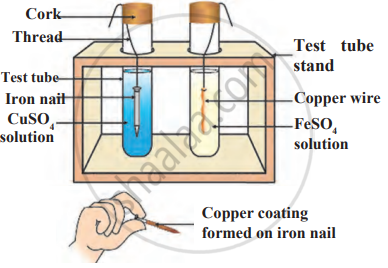Advertisements
Advertisements
Question
Three metal samples of magnesium, aluminium and iron were taken and rubbed with sandpaper. These samples were then put separately in test tubes containing dilute hydrochloric acid. Thermometers were also suspended in each test tube so that their bulbs dipped in the acid. The rate of formation of bubbles was observed. The above activity was repeated with dilute nitric acid and the observations were recorded.
Answer the following questions:
(i) When the activity was done with dilute hydrochloric acid, then in which one of the test tubes was the rate of formation of bubbles the fastest and the thermometer showed the highest temperature?
(ii) Which metal did not react with dilute hydrochloric acid? Give reason.
(iii) Why is hydrogen gas not evolved when a metal reacts with dilute nitric acid? Name the ultimate products formed in the reaction.
OR
Name the type of reaction on the basis of which the reactivity of metals is decided. You have two metals X and Y. How would you decide which is more reactive than the other?
Solution
(i) When the activity was done with dilute hydrochloric acid, the rate of bubble formation was the fastest, and the thermometer showed the highest temperature in the test tube containing magnesium. This indicates that magnesium reacted most vigorously with dilute hydrochloric acid, making the reaction the most exothermic among the metals tested.
(ii) Copper did not react with dilute hydrochloric acid. The absence of bubble formation and no change in temperature indicate that copper does not react with dilute HCl. This is due to copper's relatively low reactivity compared to magnesium, aluminium, and iron.
(iii) Hydrogen gas does not evolve when a metal reacts with dilute nitric acid because nitric acid acts as a strong oxidizing agent. It oxidizes the hydrogen gas produced in the reaction to water and is itself reduced to nitrogen oxides (N2O, NO, NO2). However, exceptions include magnesium (Mg) and manganese (Mn), which can react with very dilute nitric acid to evolve hydrogen gas. The ultimate products formed in reactions with dilute nitric acid are water and nitrogen oxides.
OR
(iii) The type of reaction based on which the reactivity of metals is decided is the displacement reaction. In such reactions, a more reactive metal can displace a less reactive metal from its compound in a solution or molten form. To determine which metal, X or Y, is more reactive, you would introduce metal X into a solution containing a compound of metal Y. If metal X displaces metal Y from its compound, then metal X is more reactive than metal Y. This method provides a simple and straightforward way to compare the reactivity of two metals.
APPEARS IN
RELATED QUESTIONS
What do you observe when ferrous sulphate solution is added to an aqueous solution of sodium hydroxide.
Fill in the blank
When a piece of copper is added to silver nitrate solution, it turns ............in colour.
How will you obtain Silver chloride from silver nitrate.
Also give balanced equations for the reactions
Write chemical equation for the event.
Electrolysis of alumina is done.
With reference to Acid explain with a suitable example of how the reactivity of the metals could be differentiated.
Explain the following reaction with the balanced equation.
Sodium burns in air
Observe the following diagram and identify the type of reaction and write observation.

Which among the following statements is incorrect for magnesium metal?
An element A reacts with water to form a compound B which is used in white washing. The compound B on heating forms an oxide C which on treatment with water gives back B. Identify A, B and C and give the reactions involved.
An element A burns with golden flame in air. It reacts with another element B, atomic number 17 to give a product C. An aqueous solution of product C on electrolysis gives a compound D and liberates hydrogen. Identify A, B, C and D. Also write down the equations for the reactions involved.
